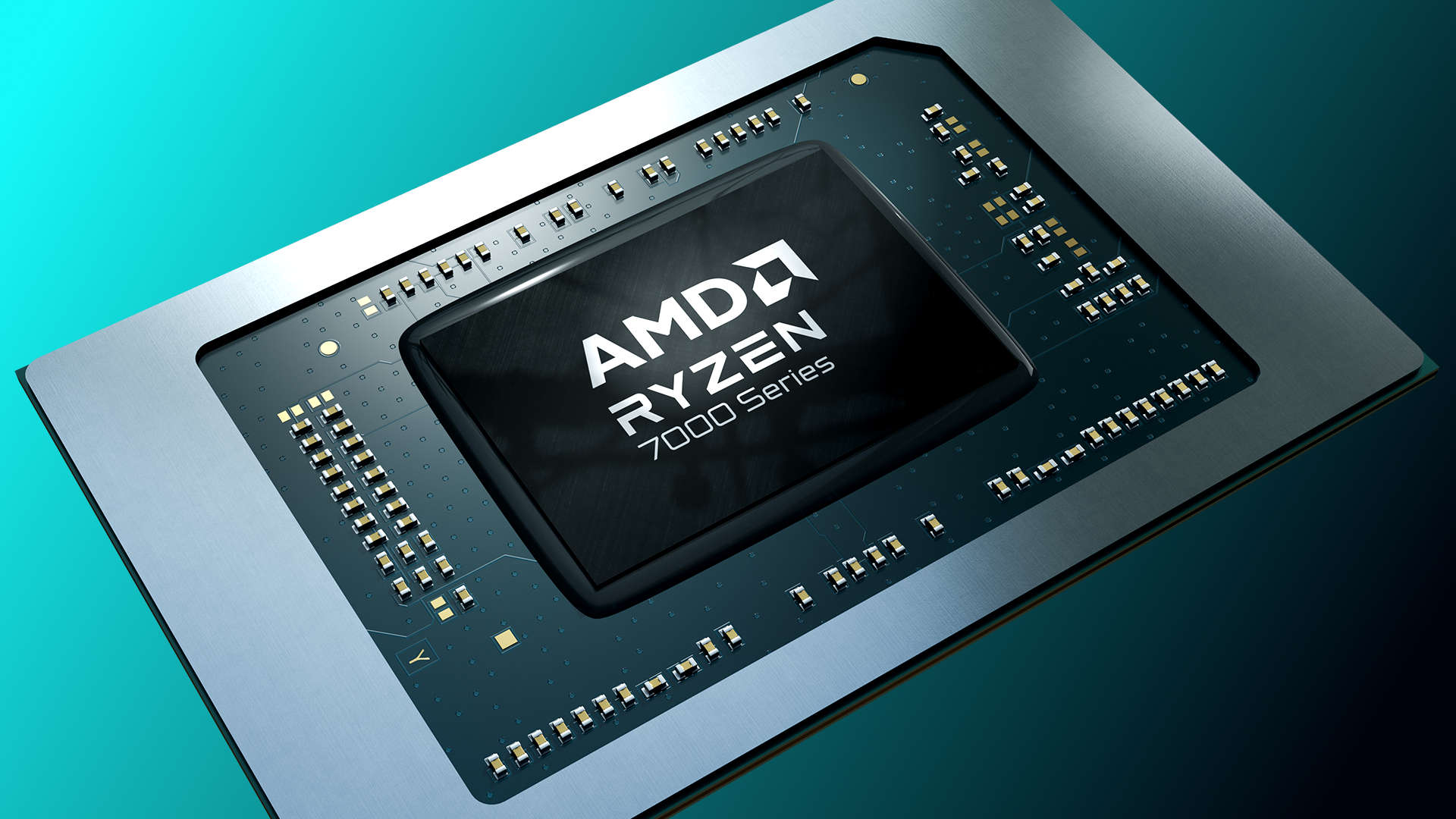Having already leveraged the smaller, optimised Zen 4c cores in its EYPC server CPUs, AMD is bringing its latest technology to the world of budget laptops with two new Ryzen APUs, sporting up to four Zen 4c cores next to two Zen 4 cores. The compact cores aren’t AMD’s version of Intel’s Efficient-cores introduced in its hybrid Alder Lake architecture, though, and AMD is certain you won’t notice any difference between them.
Up until recently, no matter what AMD CPU or APU you used, the processing cores inside them were exactly the same. From the hulking 64-core EPYC 7742 down to the tiny four core Ryzen 3 7440U, each one used the same chips to handle all of the number crunching. That all changed when AMD introduced Zen 4c, an optimised version of the Zen 4 design that shrunk the amount of die space required by 34%.
Initially just used to create mega-core CPUs specifically for the cloud server market, codenamed Bergamo, it’s now being leveraged to make APUs for entry-level laptops even more compact and energy efficient. At the moment, only two Zen 4c models are being brought to market: the six core Ryzen 5 7545U and four core Ryzen 3 7440U.
These will displace the current Ryzen 5 7540U and Ryzen 3 7440U, but since no laptop on the market appears to be using them, nobody should feel disappointed that they’ve missed out on the new technology. There’s no change in core counts or clock frequencies, but what is new is that the 7545U will be a 2+4 split between Zen 4 and Zen 4c cores, and the 7440U will be 1+3.
Not that you’d be able to tell, as AMD said in a recent briefing, “no human being would ever know the difference.” This is because Zen 4c is identical to Zen 4 in terms of how it all works. Operating systems, applications, and games will work just the same. The newer core design retains all of the same parts as before; they’re simply laid out on the die in a more compact format.
Squashing logic units together and shrinking data pathways isn’t without some cost, though, and in the case of Zen 4c, these cores can’t reach the same peak clock frequency as Zen 4 ones can. AMD also halved the L3 cache size to make the CCDs (Core Complex Dies) even smaller.
In the case of these monolithic mobile chips, however, AMD has already halved the L3 cache to squeeze Zen 4 down into the smaller dies. And that means a mobile Zen 4 core and a mobile 4c core both have the same 16MB of L3 cache, where the full desktop chiplet CCD has 32MB of L3 cache inside.
A visual comparison of how much smaller Zen 4c cores are (Image credit: AMD)
Zen 4c is smaller but has exactly the same architecture as Zen 4 (Image credit: AMD)
So, what are we getting from the use of Zen 4c here? Put simply, the chips are quite a lot smaller, so they need less power to run. In the case of laptops that means they should be a little cooler when running under load and battery life should be better, too. AMD is adamant that the performance difference at the ends of the power scale used in laptop CPUs is too small to notice or matter.
It’s also keen on pointing out that Zen 4c is not its equivalent to Intel’s E-cores. As used in Alder Lake and Raptor Lake CPUs, Intel’s Efficient-cores are much smaller in size than the regular Performance-cores but they’re less powerful, especially in gaming. Not so with the new Zen 4c APUs, says AMD, as all the cores access the same L3 cache and have the same instruction rate per clock.
These low-end processors aren’t gaming powerhouses, though, as they both sport the Radeon 740M integrated GPU. It only has four RDNA 3 compute units, just 256 shaders in total.
The scheduler built into Windows and other operating systems won’t need any additional hardware support to correctly assign threads to the appropriate core. Essentially, the chips will make use of existing systems that Ryzen processors already take advantage of, to ensure threads end up on the most suitable core.
In the case of Zen 4 + Zen 4c chips, intensive, high demand threads—so-called “bursty workloads”—will be issued to the standard cores as a priority (but not exclusively so).
Only the entry level 7040U processors are getting the Zen 4c treatment (Image credit: AMD)
The smaller Zen 4c cores shouldn’t affect performance to any noticeable degree (Image credit: AMD)
No extra hardware support is needed to manage threads across the two different core types (Image credit: AMD)
It’s not an AMD announcement if there isn’t an Intel comparison (Image credit: AMD)
Confusingly, the original 7540U and 7440U chips will still be coming to market at some point, which makes me question whether any laptop vendor would choose to go with the 7540U over the 7545U in its products. Especially those wanting to produce low-power, ultra-portable notebooks.
One point of interest in the announcement was a reminder that Zen 4c technology was already being used in AMD’s Z1 processor. That Z1 specifications are almost identical to the Ryzen 5 7545U’s, which strongly suggests that AMD has simply rebranded the chip in many handheld gaming PCs, as is seemingly the case with the Z1 Extreme and Ryzen 7 7840U.
I’ve asked AMD if there are differences in the clock speeds between the Zen 4 and Zen 4c cores in these APUs, as this wasn’t clear in the announcement, but the expectation in the past is that the Zen 4c cores are designed for lower clock speeds.
In the meantime, let’s consider the fact that AMD is also open to the possibility of using Zen 4c in more premium models. It’s unlikely that AMD is talking about replacing the likes of the Ryzen 9 7950X with chips sporting even more cores, but more rather its laptop range or perhaps even its semi-custom chips for consoles and handheld PCs.
(Image credit: Fritzchens Fritz)
Take the APU used in the PlayStation 5, for example. That comprises a custom 8-core Zen 2 CPU running up to 3,500MHz but a 30% smaller chip based entirely on Zen 4c should have no problem reaching the same clock frequency. The advantage for AMD is that smaller chips are cheaper to manufacture, whereas the best thing for us is the reduction in power consumption.
In theory, that could help AMD and Sony co-design a new APU for a PS5 Pro with a more powerful GPU inside, as a 100% Zen 4c CPU wouldn’t need as much power as the current PS5 CPU does. AMD did say that it “didn’t make sense” to have an entry-level Ryzen 5 APU made entirely from Zen 4 cores and the same may well ring true for many of its custom chips.
(Image credit: Future)
Best gaming PC: The top pre-built machines.
Best gaming laptop: Great devices for mobile gaming.
Improved power efficiency would be especially welcome in the handheld PC sector, as they are even more power limited than any full-size console. If the gaming performance of a pure Zen 4c chip is acceptable for these platforms, we may see an updated Z1 chip appearing next year, perhaps.
It’s early days for the compact version of Zen but one thing is certain, we’re going to be seeing a lot more of it in the next few years. AMD has done sterling work in keeping the CPU market fresh and forward-moving, but it’s not the only chip firm with hot new tech. Intel’s multi-tiled Meteor Lake is waiting just around the corner and Qualcomm’s impressive looking Snapdragon X Elite is set to appear in low power notebooks next year.
The game is well and truly on.











